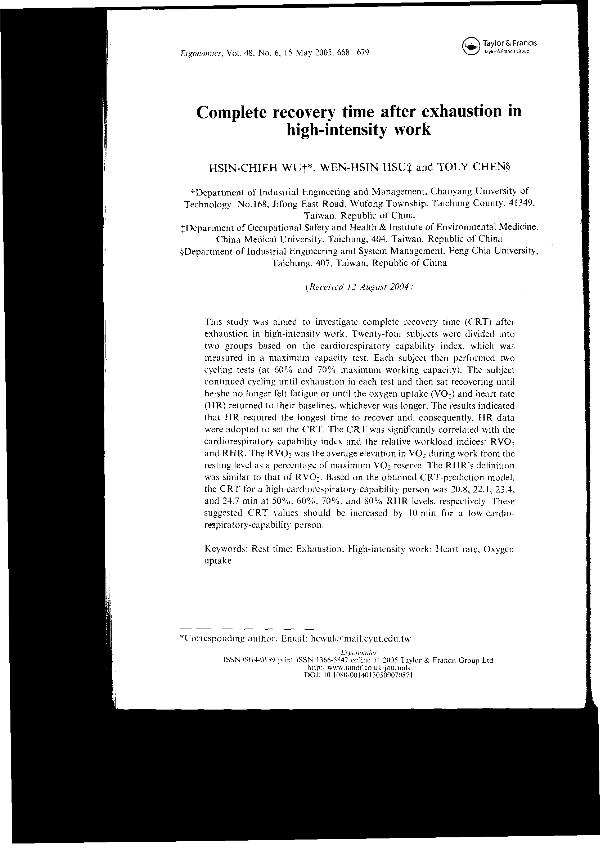Complete recovery time after exhaustion in high-intensity work

Contenido multimedia no disponible por derechos de autor o por acceso restringido. Contacte con la institución para más información.
| Tag | 1 | 2 | Valor |
|---|---|---|---|
| LDR | 00000nab a2200000 i 4500 | ||
| 001 | MAP20071507041 | ||
| 003 | MAP | ||
| 005 | 20080418125343.0 | ||
| 007 | hzruuu---uuuu | ||
| 008 | 050727e20050515gbr|||| | |00010|eng d | ||
| 035 | $a6800012720 | ||
| 040 | $aMAP$bspa | ||
| 084 | $a875 | ||
| 100 | 1 | $0MAPA20080120047$aWu, Hsin-Chieh | |
| 245 | 1 | 0 | $aComplete recovery time after exhaustion in high-intensity work$cHsin-Chieh Wu, Wen-Hsin Hsu, Toly Chen |
| 520 | 8 | $aThis study was aimed to investigate complete recovery time (CRT) after exhaustion in hight-intensity work. Twenty-four subject were divided into two groups based on the cardiorespiratory capability test. The CRT was significantly correlated with the cardiorespiratory capability index and the relative workload indices : RVO2 and RHR. The RVO2 was the average elevation in VO2 during work from the resting level as a percentage of maximum VO2 reserve. The RHR's definition was similar to that of RVO2. Based on the ontained CRT-prediction model, the CRT for a high-cardiorespiratory-capability person was 20.8, 22.1, 23.4, and 24.7 min at 50%, 60%, 70%, and 80% RHR levels, respectively. These suggusted CRT values should be increased by 10 min for a low-cardio-respiratory-capability person | |
| 650 | 1 | 1 | $0MAPA20080550653$aErgonomía |
| 650 | 1 | 1 | $0MAPA20080575731$aEjercicio físico |
| 650 | 1 | 1 | $0MAPA20080595036$aCapacidad de trabajo |
| 650 | 1 | 1 | $0MAPA20080579326$aCapacidad aerobia |
| 650 | 1 | 1 | $0MAPA20080584252$aConsumo de oxígeno |
| 700 | 1 | $0MAPA20080072063$aHsu, Wen-Hsin | |
| 700 | 1 | $0MAPA20080009946$aChen, Toly | |
| 740 | 0 | $aErgonomics | |
| 773 | 0 | $tErgonomics$dLondon and Washington$gVol. 48, nº 6, 15 May 2005 ; p. 668-679 |

